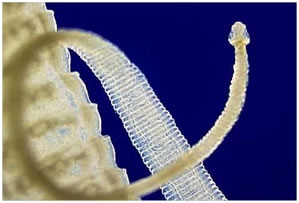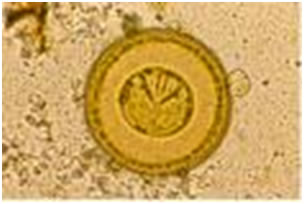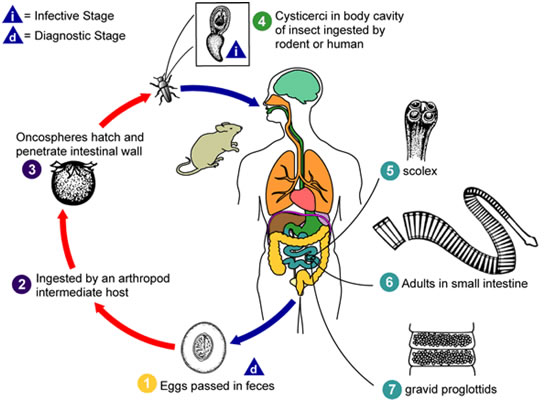

Hymenolepis diminuta (Pathogen – Intestinal Cestode)
Organism:
Hymenolepis diminuta is commonly found in rats and mice and can be found infrequently in humans. It has a worldwide distribution in normal hosts, and approximately 200 - 300 human cases have come primarily from India, the former Soviet Union, Japan, Italy, and certain areas of the southern United States (Tennessee, Georgia, and Texas).
 |
 |
| H. diminuta scolex | H. diminuta egg (no polar filaments) |
Life Cycle:
The life cycle is very similar to that of H. nana; however, the arthropod intermediate host is not optional but obligatory. A number of different arthropods (lepidopterans, earwigs, myriapods, larval fleas, and various beetles) can serve as intermediate hosts. After egg ingestion by the arthropods, the cysticercoid stage forms, which are similar in morphology to the cysticercoid stage of H. nana. Infection by accidental ingestion of the infected arthropod containing cysticercoids results in the development of the adult worm in the intestine. Unlike H. nana eggs, the eggs of H. diminuta are not infectious from person to person. As with most tapeworms, the infection is usually tolerated very well by the host, with few if any symptoms. This infection is a true zoonosis, since infected rats infect insects, which in turn are consumed by humans.

Acquired:
Infection in humans is acquired through ingestion of immature tapeworm larvae, cysticercoid, from infected arthropods
Epidemiology:
Worldwide
Clinical Features:
As with most tapeworms, the infection is usually tolerated very well by the host, with few if any symptoms. Most infections have been reported from children less than three years of age; however, infected adults have also been reported. Symptoms that have been reported include diarrhea, anorexia, nausea, headache, and dizziness; they are most likely seen in infected children with a heavy infection.
Clinical Specimen:
Stool: The standard O&P examination is the recommended procedure for recovery and identification of H. diminuta eggs in stool specimens, primarily from the wet preparation examination of the concentration sediment.
Adult worms: Adult worms are rarely seen.
Laboratory Diagnosis:
Stool: The standard O&P examination is the recommended procedure for recovery and identification of H. diminuta eggs in stool specimens, primarily from the wet preparation examination of the concentration sediment. The eggs are most easily seen on a direct wet smear or a wet preparation of the concentration sediment.
Adult worms The scolex has four suckers and a short rostellum with hooks. The adult worm is rarely seen in the stool.
Organism Description:
Egg: Since the eggs of H. nana and H. diminuta look very much alike, identification to the visual identification of the polar filaments seen in H. nana eggs. The eggs are round to oval with a thin shell and measure 60 to 79 µm in diameter. The oncosphere has no polar thickenings and no polar filaments.
Adult worm: The scolex has four suckers and no hooks. The adult worm is rarely seen in the stool. H. diminuta is larger than H. nana, reaching a length of at least 1 m in single infections in rats and perhaps even more in humans. The eggs are released by the disintegration of the gravid proglottids and pass out in the stool.
The worms are very small compared with worms of the Taenia species and measure up to 40 mm long. The more worms present, the shorter the total length of each worm.
Laboratory Report:
Hymenolepis nana eggs present.
Proficiency Testing:
In Proficiency Testing specimens, the eggs may not always have hooklets visible within the oncosphere. The hooklets will be more easily seen in stool specimens that have not been stored for a long time in formalin.
Treatment:
Garcia, L.S. 2007. Diagnostic Medical Parasitology, 5th ed., ASM Press, Washington, D.C.
Control:
Since the infection is acquired from the accidental ingestion of the infected intermediate arthropod hosts, avoidance of this type of exposure is recommended. Possible situations include swallowing ectoparasites from the rodent host or accidentally ingesting beetles in precooked cereals. Rat control programs might also decrease the possibility of human exposure.